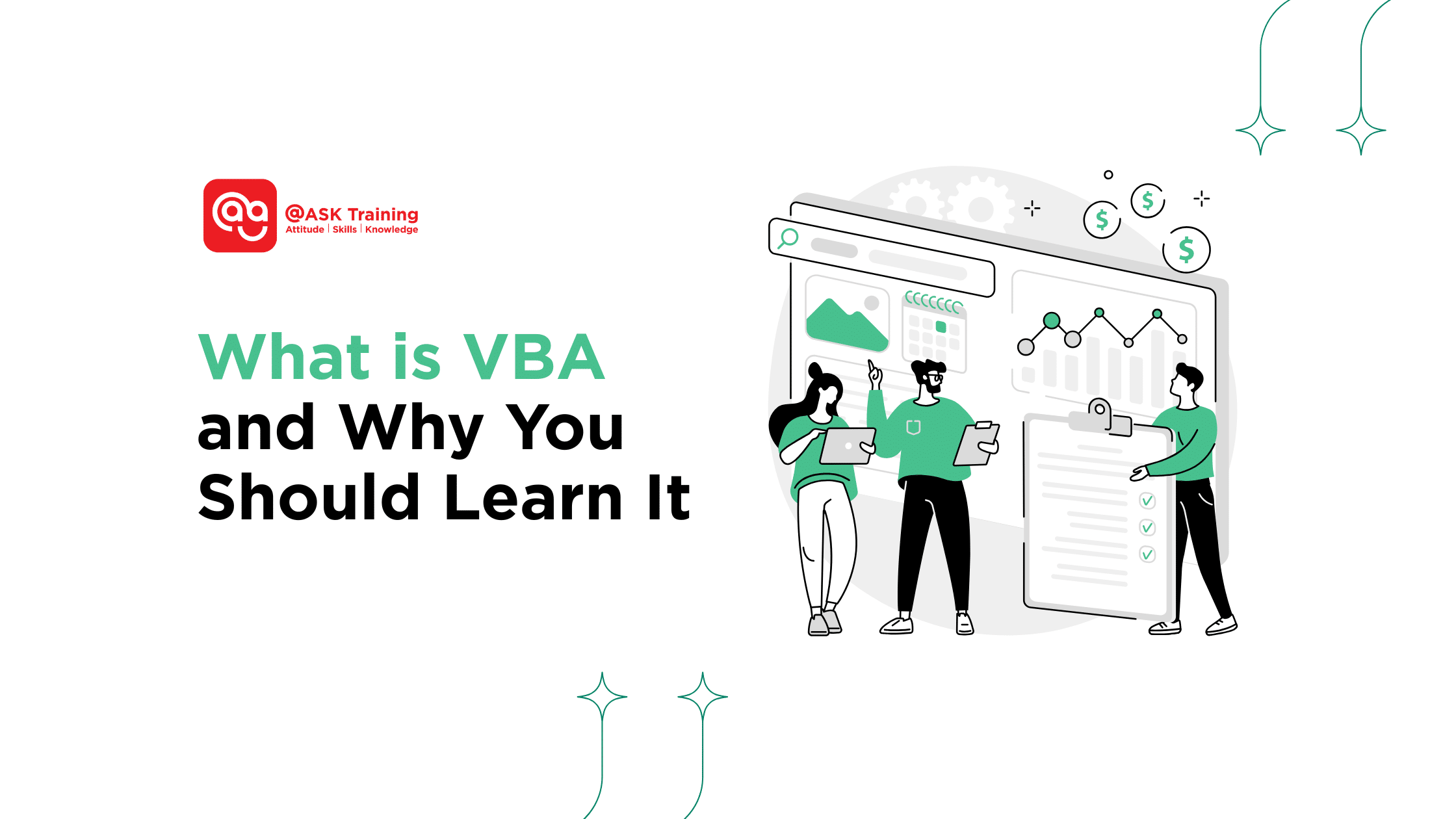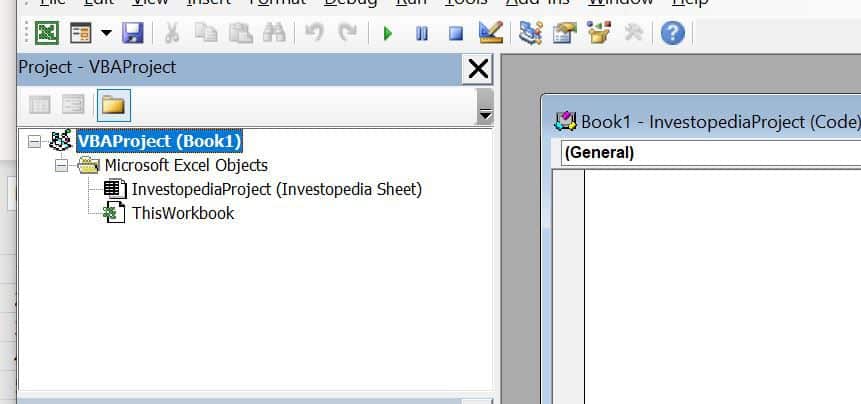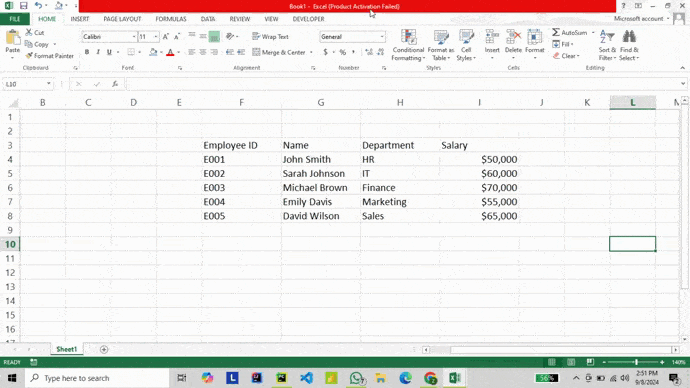Let’s face it! Manual, repetitive tasks are the bane of any professional’s workday. If you’ve spent hours formatting spreadsheets or compiling reports, you’ll know exactly what we mean.
But what if there were a way to automate these tedious tasks and reclaim your time? Enter VBA (Visual Basic for Applications). A powerful yet often overlooked tool built right into Microsoft Office.
Whether you’re an Excel power user, a mid-level professional looking to streamline workflows, or a career switcher exploring automation skills, learning VBA for Excel and other Office tools can give you a competitive edge.
This article explains what VBA is used for, its real-world applications, and why learning VBA remains a smart career move in 2025.
First things first, what is VBA?
What is VBA?
If you’ve ever wished for a way to make Excel do the heavy lifting for you, you’re already thinking like a VBA user.
VBA, or Visual Basic for Applications, is a programming language developed by Microsoft specifically for automating tasks in Office applications.
(Source: Investopedia)
Here’s the kicker: While many think VBA is just for Excel, it actually works across:
- Excel: For complex calculations and data processing
- Word: For document automation and mail merges
- Access: For database management and reporting
- Outlook: For email processing and calendar management
Think of it as a behind-the-scenes assistant that follows your instructions to complete repetitive work faster and error-free.
Why Does This Matter?
- Automation: No more copying, pasting, or reformatting data manually.
- Customisation: Build solutions tailored to your exact needs (e.g., a one-click report generator).
- Integration: Seamlessly link data between Office apps, such as pulling Outlook contacts into Excel.
Understanding what VBA is leads us to an important question: Why should you invest time in learning it in today’s tech landscape?
Why Learn VBA?
Now, you might be thinking: “Sure, automation sounds great, but is VBA really worth learning?”
The short answer? Yes. Here’s why:
1. Boost Productivity (and Sanity)
Let’s be honest, no one enjoys mind-numbing tasks like data entry or report generation. With VBA automation, you can turn hours of work into a single button click.
Real-world example: A finance analyst automates budget tracking, saving over 10 hours a month, which can be better spent on strategic analysis.
2. Create Custom Solutions
Recording a Macro using VBA in Excel
(Source: Data Camp)
Many businesses rely on Excel macros to build interactive dashboards, dynamic charts, and automated workflows. HR teams, for example, use VBA to track employee attendance or generate payroll summaries with a single click.
3. Seamless Microsoft Office Integration
VBA acts as a bridge between Office applications. Need to extract data from an Access database and compile it into a Word report? VBA makes it possible without switching between tools manually.
4. Future-Proof Your Skills
Even in 2025, VBA remains deeply embedded in business processes. While newer tools like Power Query and Python have their place, VBA is still the go-to for Microsoft Office automation.
How VBA is Used in the Real World?
If you’re still on the fence, let’s look at how professionals across industries use VBA to make their lives easier.
Finance & Accounting
- Automated Reconciliation: Match thousands of transactions in minutes
- Dynamic Reporting: Financial statements that update with source data
- Budget Tools: Self-calculating templates with variance alerts
Example: A local SME automated their GST reporting, reducing compliance preparation from 3 days to 2 hours.
HR Departments
- Onboarding Systems: New hire paperwork generated from a single form
- Leave Trackers: Real-time balance calculations with manager alerts
- Compensation Analysis: Automated benchmarking against market data
Operations
- Inventory Management: Stock level alerts with reorder triggers
- Production Scheduling: Capacity planning tools
- Logistics Tracking: Shipment status dashboards
Seeing these practical VBA examples being applied might make you wonder: How difficult is it actually to learn Excel’s VBA?
Getting Started with VBA: Accessibility and Ease
If you’re new to programming, here’s good news: VBA is one of the most accessible languages to learn, especially if you already use Excel or Word regularly.
Why VBA is Beginner-Friendly:
- Familiar Environment: You’re already working in Office apps daily; VBA just extends what you can do.
- Instant Results: Run a macro and see changes immediately, making troubleshooting straightforward.
- Built-In Tools: The Macro Recorder writes code for you—perfect for understanding basic structures.
Pro Tip: Start by recording simple tasks (like formatting a table), then examine the generated code to learn how it works. Within weeks, you’ll be tweaking scripts to fit your exact needs.
VBA vs Newer Tools
With Power Query, Python, and Power Automate getting attention, where does VBA fit in 2025?
| Feature | VBA | Power Query | Python |
| Office Integration | Excellent | Good | Requires setup |
| Learning Curve | Low | Medium | High |
| Speed for Simple Tasks | Fastest | Fast | Slower |
| Customisation | High | Medium | Highest |
| Works Offline | Yes | Yes | Yes |
When to Consider Alternatives:
- Big Data: For datasets exceeding 1 million rows, Power Query may help.
- Advanced Analytics: Python has superior statistical libraries.
- Cloud Workflows: Power Automate connects cloud services better.
Many local businesses use hybrid approaches: VBA for core Office automation with Power BI for visualisation.
Is VBA Still Relevant in 2025?
With flashy new tools like Power Automate and Python dominating headlines, you might wonder if VBA is outdated. Here’s the reality:
Why VBA Holds Its Ground:
- No Dependencies: Need automation that works offline? VBA runs natively in Office; no IT approvals or cloud connections required.
- Speed: For tasks like formatting reports or processing data, VBA often outperforms bulkier alternatives.
- Cross-App Magic: It’s still the best “glue” for Office workflows (e.g., emailing Outlook data to an Excel tracker or populating Word templates from Access).
Now that you understand VBA’s enduring value, let’s wrap this up.
Final Thoughts
In our age of AI and cloud computing, you might think VBA is outdated. Let’s recap why VBA deserves a spot in your skillset.
Key Takeaways:
- What It Is: A powerful automation tool built into Microsoft Office.
- Why Learn It: Saves hours weekly, solves unique problems, and boosts your career value.
- Where It Shines: Finance, HR, operations, and any role drowning in repetitive tasks.
Ready to Start?
- Identify Pain Points: List your most repetitive tasks.
- Start Small: Automate one simple process this week.
- Build Gradually: Add complexity as you gain confidence.
- Consider Training: Structured learning accelerates progress.
You can also try out these free Excel VBA exercises:
In 2025 and beyond, VBA remains the silent productivity booster that separates average users from Office power players. The only question left: What will you automate first?
Ready to Work Smarter with Excel & VBA?
If you use Excel regularly, you’ve probably thought: “There must be a better way.”
@ASK Training offers a range of Microsoft Excel courses designed to provide you with practical skills directly relevant to your work.
Here are a few courses worth exploring:
- Visual Basic for Applications (VBA) in Microsoft Excel – Fundamental: Learn the Excel programming environment, perfect for beginners.
- WSQ Microsoft Excel Mastery: Learn to use Excel’s advanced features for probability computations, data analysis, and statistical tools.
- WSQ Microsoft Excel Advanced: Dive into advanced skills including statistical formulas, PivotTables, data queries, and automation.
Enrol with us today and let’s transform how you work with Excel!
Related Courses
- Visual Basic for Applications (VBA) in Microsoft Excel – Fundamental
- WSQ Microsoft Excel Mastery
- WSQ Microsoft Excel Advanced
◆◆◆



